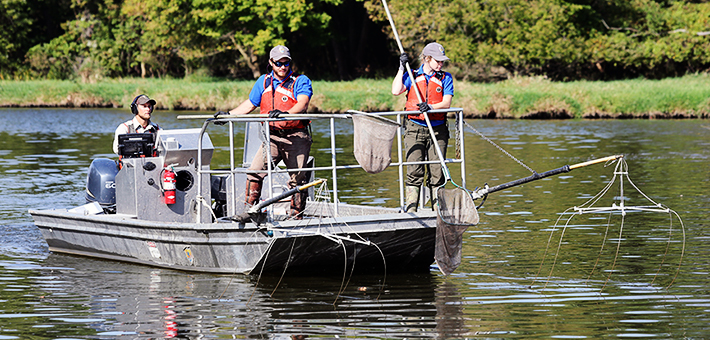USFWS Shares Results of Studies on Small Fish Movement and Barge Traffic
October 15, 2015
Contact: Katie Steiger-Meister, 612-713-5317, Katie_Steiger-Meister@fws.gov

U.S. Fish and Wildlife Service Wilmington Substation employees electrofish for small Asian carp in Marseilles pool of the Illinois Waterway.
Photo by Gary Chancey/USFS.
This past year, the U.S. Fish and Wildlife Service conducted studies to test whether small fish could become trapped in the underwater spaces between commercial barges and inadvertently transported over various distances and across electrical barriers. The U.S. Army Corps of Engineers operates a system of three electrical fish dispersal barriers in the Chicago Sanitary and Ship Canal, which are designed to prevent the movement of non-native fish, including Asian carps, between the Great Lakes and Mississippi River basins. Research used golden shiners to examine the impact of commercial barge traffic on small fish movement to better understand the potential risk of small Asian carp passing through the electrical fish dispersal barriers in the Chicago Sanitary and Ship Canal.
Preliminary results of this research indicate that small fish can become entrained between barges and subsequently transported measurable distances, through a lock and dam system, and across electrical barriers. Since this study exclusively used golden shiners, we do not know if juvenile Asian carp would respond the same way.
We have no evidence that Asian carp have ever crossed the electrical barriers in this way. To date, the nearest we have documented small Asian carp (less than six inches in length) is more than 50 miles downstream of the electrical barriers. However, this study indicates that there is the potential risk that commercial barge traffic could inadvertently facilitate the movement of small fish, including Asian carps, by entraining and transporting them upstream through locks and across the electrical barriers.
The Service is working with the U.S. Army Corps of Engineers and our other federal and state partners to explore actions we can take to reduce these risks. We will also continue to assist the state of Illinois and the U.S. Army Corps of Engineers in monitoring the Chicago Sanitary and Ship Canal for any presence of Asian carps.

